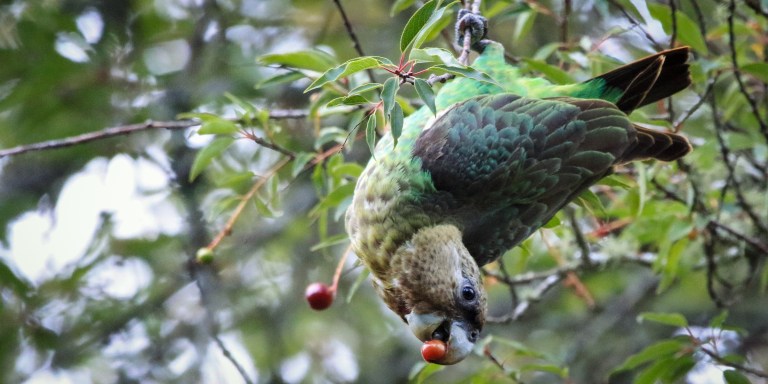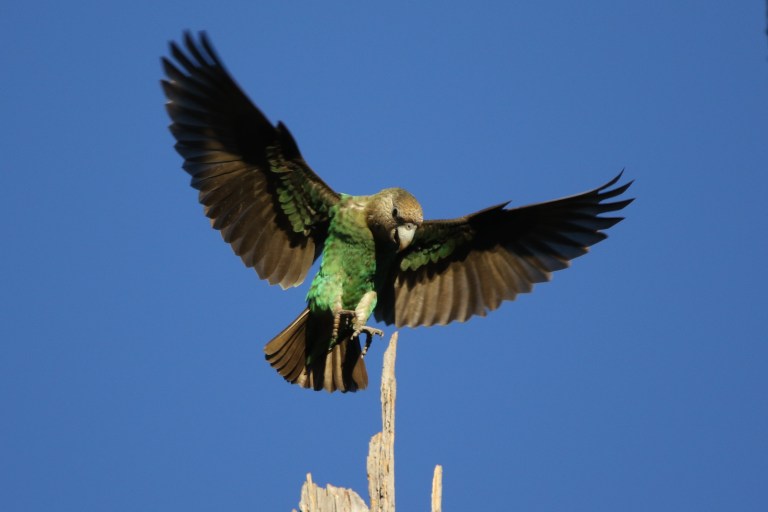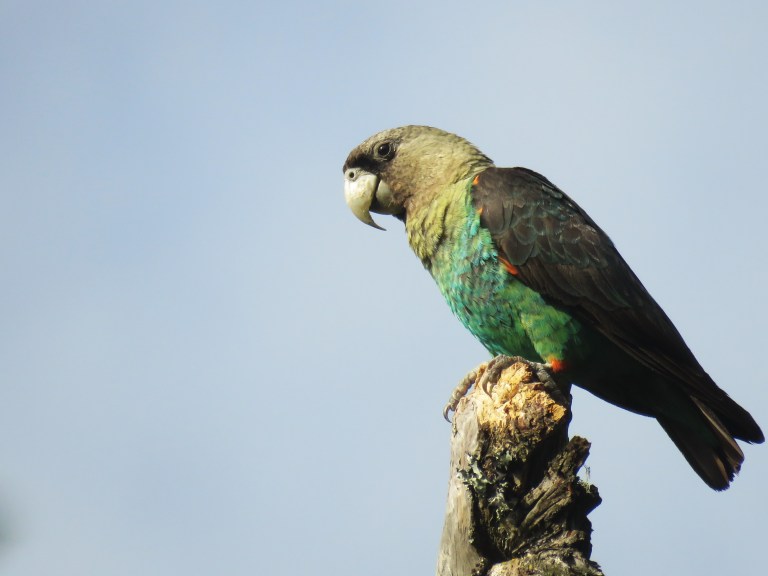Cape Parrot
- Lisbeth
- Site Admin
- Posts: 67582
- Joined: Sat May 19, 2012 12:31 pm
- Country: Switzerland
- Location: Lugano
- Contact:
Re: Cape Parrot
Always something to learn 
"Education is the most powerful weapon which you can use to change the world." Nelson Mandela
The desire for equality must never exceed the demands of knowledge
The desire for equality must never exceed the demands of knowledge
- Lisbeth
- Site Admin
- Posts: 67582
- Joined: Sat May 19, 2012 12:31 pm
- Country: Switzerland
- Location: Lugano
- Contact:
Re: Cape Parrot
Flight of their lives — inside the mission to save the critically endangered Cape parrot

The Cape parrot is the only endemic parrot species in South Africa and occurs nowhere else. (Photo: Cassie Carstens)
By Liz Clarke | 05 Feb 2024
Could the intelligent green-and-gold Cape species become a South African sporting emblem?
_____________________________________________________________________________________________________________________
The “green jewel” of South African mistbelt forests is how birders describe the charismatic and critically endangered Cape parrot.
If you see one, hold your breath and make a wish that in 20 or so years it won’t have left Planet Earth for good.
BirdLife South Africa chose the Cape parrot as its Bird of the Year in 2023.
Plenty of exposure came its way – from community buy-in to birding seminars, and T-shirts to children’s colouring-in books. Now that the excitement and fanfare are dying down and another bird has taken its place, one has to ask: What now for the green jewel that sparked so much interest?
The issues remain the same. The race to save the last remaining natural habitat of the Cape parrot, the only endemic parrot species in South Africa that occurs nowhere else on Earth, is still critical. Mistbelt forests are still being degraded.
With a wild population of fewer than 2,000 birds, according to a recent assessment, the fear remains that, if the numbers dwindle further, extinction looms large.

The Cape parrot is a flagship species for South African biodiversity. (Photo: Cassie Carstens)
We tapped into the latest discussions on the future of the Cape parrot and ongoing efforts to save the species.
The first question to be asked has to be what changed specifically for these once prolific, small but colourful birds, in their natural forest habitats? In short, the mistbelt forests that existed in parts of KwaZulu-Natal, Limpopo and the Eastern Cape for thousands of years became the target for commercial logging.
Yellowwood trees, the preferred feeding and nesting places of Cape parrots, were the worst affected by indiscriminate logging. Although this level of logging no longer takes place in South Africa’s forests, which are now protected under the National Forest Act, shortages of food for the birds, limited nesting opportunities, depleted groundwater, exotic plant invasions, and unsustainable harvesting of forest products are some of the factors contributing to dwindling numbers.
Those are the problems. What are the solutions?
Dr Kirsten Wimberger, trustee of the Wild Bird Trust and director of the Cape Parrot Project, has a single idea in mind: Forest conservation.
“The outlook for the Cape parrot is still of concern, there’s no doubt about that,” she emphasises.
“What the Cape Parrot Project is hoping to do, as a BirdLife South Africa species guardian, is to reverse the situation by conserving forests through restoration efforts. We had such a great celebration when the Cape parrot was chosen as Bird of the Year. We live and breathe Cape parrots every day, and feel that everyone should know more about this unique bird.”
In 2023, the restoration of four hectares of forest began with the planting of more than 10,000 new trees. Importantly, says Wimberger, these efforts need to be combined with addressing the need to better protect and manage forests.
“We view the conservation of the Cape parrot as far more than saving just one bird but as an icon for the conservation of South Africa’s fragile forest habitats. We are using this beautiful, loud species to bring attention to the state that these forests are in.”
Dr Melissa Whitecross, a committee member of the Cape Parrot Action Plan Coordinating Committee, echoes these thoughts: “As South Africa’s only endemic parrot, the Cape parrot is a flagship species for mistbelt forests, which span much of eastern South Africa’s escarpment.”

Habitat loss is the biggest threat to Cape parrots, but they are also poached and traded. (Photo: Cassie Carstens)
The work of BirdLife’s species guardians (groups tasked with research and conservation actions), she explains, includes population monitoring, habitat restoration, provision of nest boxes, species rehabilitation, and education of the public.
As another species guardian, the Cape Parrot Working Group, under Professor Colleen Downs in KwaZulu-Natal and the Eastern Cape, commented that mistbelt forests are important, not only for fauna and flora, but also for water catchment protection and carbon capture and storage.
David Letsoalo, a BirdLife South Africa-trained community bird guide based in the Magoebaskloof area who has been involved in conservation of the species for two decades, encountered the Cape parrot when he joined a Cape parrot census in the early 2000s.
“Now, when I hear them calling and see them flying, I feel proud to have played a part in conserving this special bird.”
It has even been suggested that the green-and-gold parrot, known for its intelligence and ingenuity, should become an emblem for a South African sporting team. Go Parrots! DM
More about the Cape Parrot
Like all members of the Psittaciformes (the parrot family), Cape parrots are charismatic little characters; brightly coloured and intelligent. Similar in size to the African grey parrot (but with a larger beak), they measure between 251mm and 349mm in length and weigh between 260g and 329g. Though they are predominantly green, the outer edges of their wings and shoulders are highlighted in a vivid orange/red. The juveniles and females have a bright orange/red patch on their foreheads, which the males typically lose upon reaching adulthood.
Quiz trivia
What do Dr Doolittle, Winston Churchill and Alexander the Great have in common? They all loved parrots. So too did the ancient Egyptians and Greeks. Although the talking kind have their own unique humanised attributes, and can easily live for more than half a century, the scientific focus today is more on preserving the habitat of the 400 or so wild species that inhabit the planet.
Did you know that World Parrot Day is celebrated on 31 May? For more information go to the official site of the World Parrot Trust. DM

The Cape parrot is the only endemic parrot species in South Africa and occurs nowhere else. (Photo: Cassie Carstens)
By Liz Clarke | 05 Feb 2024
Could the intelligent green-and-gold Cape species become a South African sporting emblem?
_____________________________________________________________________________________________________________________
The “green jewel” of South African mistbelt forests is how birders describe the charismatic and critically endangered Cape parrot.
If you see one, hold your breath and make a wish that in 20 or so years it won’t have left Planet Earth for good.
BirdLife South Africa chose the Cape parrot as its Bird of the Year in 2023.
Plenty of exposure came its way – from community buy-in to birding seminars, and T-shirts to children’s colouring-in books. Now that the excitement and fanfare are dying down and another bird has taken its place, one has to ask: What now for the green jewel that sparked so much interest?
The issues remain the same. The race to save the last remaining natural habitat of the Cape parrot, the only endemic parrot species in South Africa that occurs nowhere else on Earth, is still critical. Mistbelt forests are still being degraded.
With a wild population of fewer than 2,000 birds, according to a recent assessment, the fear remains that, if the numbers dwindle further, extinction looms large.

The Cape parrot is a flagship species for South African biodiversity. (Photo: Cassie Carstens)
We tapped into the latest discussions on the future of the Cape parrot and ongoing efforts to save the species.
The first question to be asked has to be what changed specifically for these once prolific, small but colourful birds, in their natural forest habitats? In short, the mistbelt forests that existed in parts of KwaZulu-Natal, Limpopo and the Eastern Cape for thousands of years became the target for commercial logging.
- We view the conservation of the Cape parrot as far more than saving just one bird but as an icon for the conservation of South Africa’s fragile forest habitats.
Yellowwood trees, the preferred feeding and nesting places of Cape parrots, were the worst affected by indiscriminate logging. Although this level of logging no longer takes place in South Africa’s forests, which are now protected under the National Forest Act, shortages of food for the birds, limited nesting opportunities, depleted groundwater, exotic plant invasions, and unsustainable harvesting of forest products are some of the factors contributing to dwindling numbers.
Those are the problems. What are the solutions?
Dr Kirsten Wimberger, trustee of the Wild Bird Trust and director of the Cape Parrot Project, has a single idea in mind: Forest conservation.
“The outlook for the Cape parrot is still of concern, there’s no doubt about that,” she emphasises.
“What the Cape Parrot Project is hoping to do, as a BirdLife South Africa species guardian, is to reverse the situation by conserving forests through restoration efforts. We had such a great celebration when the Cape parrot was chosen as Bird of the Year. We live and breathe Cape parrots every day, and feel that everyone should know more about this unique bird.”
In 2023, the restoration of four hectares of forest began with the planting of more than 10,000 new trees. Importantly, says Wimberger, these efforts need to be combined with addressing the need to better protect and manage forests.
“We view the conservation of the Cape parrot as far more than saving just one bird but as an icon for the conservation of South Africa’s fragile forest habitats. We are using this beautiful, loud species to bring attention to the state that these forests are in.”
Dr Melissa Whitecross, a committee member of the Cape Parrot Action Plan Coordinating Committee, echoes these thoughts: “As South Africa’s only endemic parrot, the Cape parrot is a flagship species for mistbelt forests, which span much of eastern South Africa’s escarpment.”

Habitat loss is the biggest threat to Cape parrots, but they are also poached and traded. (Photo: Cassie Carstens)
The work of BirdLife’s species guardians (groups tasked with research and conservation actions), she explains, includes population monitoring, habitat restoration, provision of nest boxes, species rehabilitation, and education of the public.
As another species guardian, the Cape Parrot Working Group, under Professor Colleen Downs in KwaZulu-Natal and the Eastern Cape, commented that mistbelt forests are important, not only for fauna and flora, but also for water catchment protection and carbon capture and storage.
David Letsoalo, a BirdLife South Africa-trained community bird guide based in the Magoebaskloof area who has been involved in conservation of the species for two decades, encountered the Cape parrot when he joined a Cape parrot census in the early 2000s.
“Now, when I hear them calling and see them flying, I feel proud to have played a part in conserving this special bird.”
It has even been suggested that the green-and-gold parrot, known for its intelligence and ingenuity, should become an emblem for a South African sporting team. Go Parrots! DM
More about the Cape Parrot
Like all members of the Psittaciformes (the parrot family), Cape parrots are charismatic little characters; brightly coloured and intelligent. Similar in size to the African grey parrot (but with a larger beak), they measure between 251mm and 349mm in length and weigh between 260g and 329g. Though they are predominantly green, the outer edges of their wings and shoulders are highlighted in a vivid orange/red. The juveniles and females have a bright orange/red patch on their foreheads, which the males typically lose upon reaching adulthood.
Quiz trivia
What do Dr Doolittle, Winston Churchill and Alexander the Great have in common? They all loved parrots. So too did the ancient Egyptians and Greeks. Although the talking kind have their own unique humanised attributes, and can easily live for more than half a century, the scientific focus today is more on preserving the habitat of the 400 or so wild species that inhabit the planet.
Did you know that World Parrot Day is celebrated on 31 May? For more information go to the official site of the World Parrot Trust. DM
"Education is the most powerful weapon which you can use to change the world." Nelson Mandela
The desire for equality must never exceed the demands of knowledge
The desire for equality must never exceed the demands of knowledge


